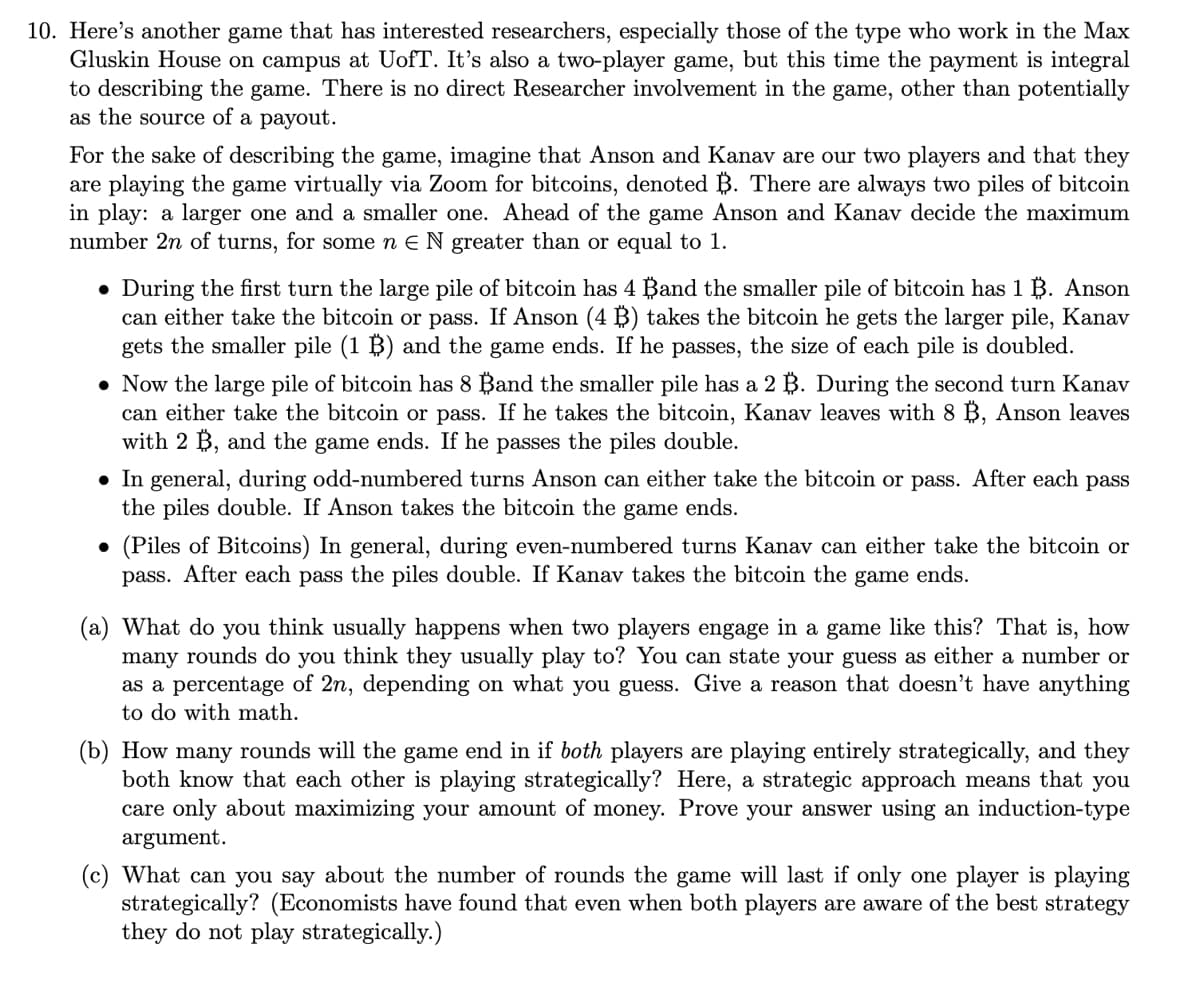Here's another game that has interested researchers, especially those of the type who work in the Max Gluskin House on campus at UofT. It's also a two-player game, but this time the payment is integral to describing the game. There is no direct Researcher involvement in the game, other than potentially as the source of a payout. For the sake of describing the game, imagine that Anson and Kanav are our two players and that they are playing the game virtually via Zoom for bitcoins, denoted B. There are always two piles of bitcoin in play: a larger one and a smaller one. Ahead of the game Anson and Kanav decide the maximum number 2n of turns, for some n EN greater than or equal to 1.
Here's another game that has interested researchers, especially those of the type who work in the Max Gluskin House on campus at UofT. It's also a two-player game, but this time the payment is integral to describing the game. There is no direct Researcher involvement in the game, other than potentially as the source of a payout. For the sake of describing the game, imagine that Anson and Kanav are our two players and that they are playing the game virtually via Zoom for bitcoins, denoted B. There are always two piles of bitcoin in play: a larger one and a smaller one. Ahead of the game Anson and Kanav decide the maximum number 2n of turns, for some n EN greater than or equal to 1.
Principles of Microeconomics (MindTap Course List)
8th Edition
ISBN:9781305971493
Author:N. Gregory Mankiw
Publisher:N. Gregory Mankiw
Chapter17: Oligopoly
Section: Chapter Questions
Problem 9PA
Related questions
Question

Transcribed Image Text:10. Here's another game that has interested researchers, especially those of the type who work in the Max
Gluskin House on campus at UofT. It's also a two-player game, but this time the payment is integral
to describing the game. There is no direct Researcher involvement in the game, other than potentially
as the source of a payout.
For the sake of describing the game, imagine that Anson and Kanav are our two players and that they
are playing the game virtually via Zoom for bitcoins, denoted B. There are always two piles of bitcoin
in play: a larger one and a smaller one. Ahead of the game Anson and Kanav decide the maximum
number 2n of turns, for some n E N greater than or equal to 1.
• During the first turn the large pile of bitcoin has 4 Band the smaller pile of bitcoin has 1 B. Anson
can either take the bitcoin or pass. If Anson (4 B) takes the bitcoin he gets the larger pile, Kanav
gets the smaller pile (1 B) and the game ends. If he passes, the size of each pile is doubled.
• Now the large pile of bitcoin has 8 Band the smaller pile has a 2 B. During the second turn Kanav
can either take the bitcoin or pass. If he takes the bitcoin, Kanav leaves with 8 B, Anson leaves
with 2 B, and the game ends. If he passes the piles double.
• In general, during odd-numbered turns Anson can either take the bitcoin or pass. After each pass
the piles double. If Anson takes the bitcoin the game ends.
• (Piles of Bitcoins) In general, during even-numbered turns Kanav can either take the bitcoin or
pass. After each pass the piles double. If Kanav takes the bitcoin the game ends.
(a) What do you think usually happens when two players engage in a game like this? That is, how
many rounds do you think they usually play to? You can state your guess as either a number or
as a percentage of 2n, depending on what you guess. Give a reason that doesn't have anything
to do with math.
(b) How many rounds will the game end in if both players are playing entirely strategically, and they
both know that each other is playing strategically? Here, a strategic approach means that you
care only about maximizing your amount of money. Prove your answer using an induction-type
argument.
(c) What can you say about the number of rounds the game will last if only one player is playing
strategically? (Economists have found that even when both players are aware of the best strategy
they do not play strategically.)
Expert Solution
This question has been solved!
Explore an expertly crafted, step-by-step solution for a thorough understanding of key concepts.
This is a popular solution!
Trending now
This is a popular solution!
Step by step
Solved in 4 steps

Recommended textbooks for you

Principles of Microeconomics (MindTap Course List)
Economics
ISBN:
9781305971493
Author:
N. Gregory Mankiw
Publisher:
Cengage Learning

Principles of Economics (MindTap Course List)
Economics
ISBN:
9781305585126
Author:
N. Gregory Mankiw
Publisher:
Cengage Learning

Principles of Economics, 7th Edition (MindTap Cou…
Economics
ISBN:
9781285165875
Author:
N. Gregory Mankiw
Publisher:
Cengage Learning

Principles of Microeconomics (MindTap Course List)
Economics
ISBN:
9781305971493
Author:
N. Gregory Mankiw
Publisher:
Cengage Learning

Principles of Economics (MindTap Course List)
Economics
ISBN:
9781305585126
Author:
N. Gregory Mankiw
Publisher:
Cengage Learning

Principles of Economics, 7th Edition (MindTap Cou…
Economics
ISBN:
9781285165875
Author:
N. Gregory Mankiw
Publisher:
Cengage Learning


Principles of Microeconomics
Economics
ISBN:
9781305156050
Author:
N. Gregory Mankiw
Publisher:
Cengage Learning

Microeconomics: Principles & Policy
Economics
ISBN:
9781337794992
Author:
William J. Baumol, Alan S. Blinder, John L. Solow
Publisher:
Cengage Learning